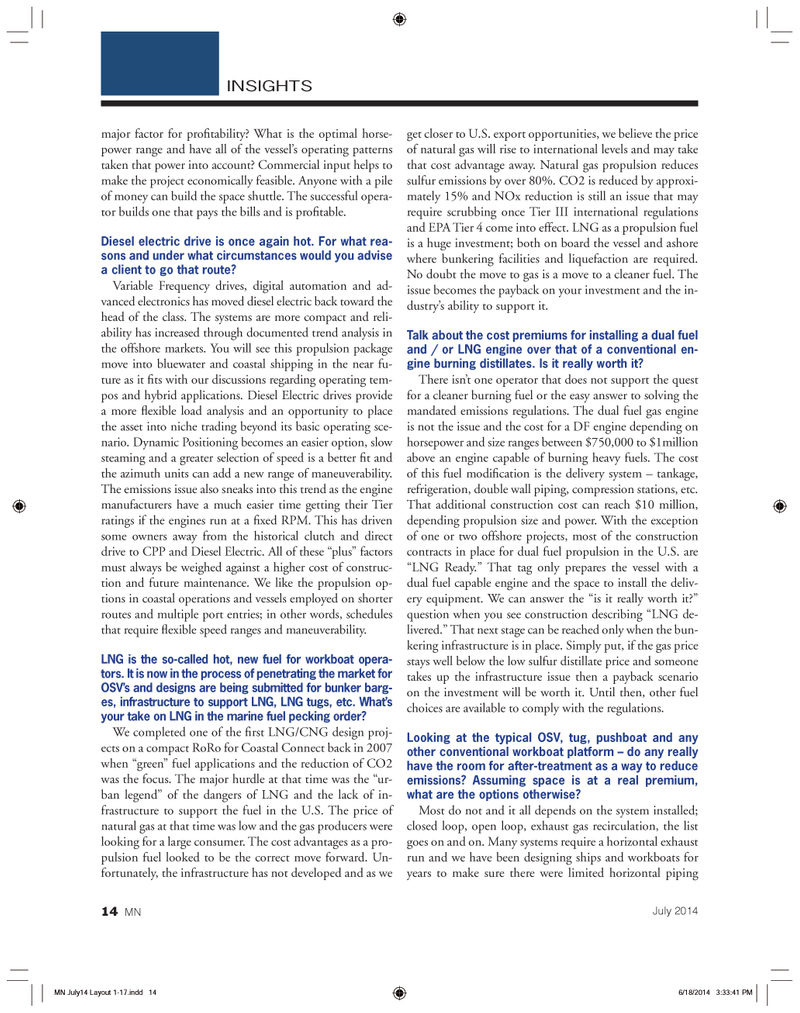
Page 14: of Marine News Magazine (July 2014)
ATB Technical Trends
Read this page in Pdf, Flash or Html5 edition of July 2014 Marine News Magazine
major factor for proÞ tability? What is the optimal horse- power range and have all of the vesselÕs operating patterns taken that power into account? Commercial input helps to make the project economically feasible. Anyone with a pile of money can build the space shuttle. The successful opera- tor builds one that pays the bills and is proÞ table. Diesel electric drive is once again hot. For what rea- sons and under what circumstances would you advise a client to go that route? Variable Frequency drives, digital automation and ad- vanced electronics has moved diesel electric back toward the head of the class. The systems are more compact and reli- ability has increased through documented trend analysis in the offshore markets. You will see this propulsion package move into bluewater and coastal shipping in the near fu- ture as it Þ ts with our discussions regarding operating tem- pos and hybrid applications. Diesel Electric drives provide a more ß exible load analysis and an opportunity to place the asset into niche trading beyond its basic operating sce- nario. Dynamic Positioning becomes an easier option, slow steaming and a greater selection of speed is a better Þ t and the azimuth units can add a new range of maneuverability. The emissions issue also sneaks into this trend as the engine manufacturers have a much easier time getting their Tier ratings if the engines run at a Þ xed RPM. This has driven some owners away from the historical clutch and direct drive to CPP and Diesel Electric. All of these ÒplusÓ factors must always be weighed against a higher cost of construc- tion and future maintenance. We like the propulsion op- tions in coastal operations and vessels employed on shorter routes and multiple port entries; in other words, schedules that require ß exible speed ranges and maneuverability. LNG is the so-called hot, new fuel for workboat opera-tors. It is now in the process of penetrating the market for OSV?s and designs are being submitted for bunker barg- es, infrastructure to support LNG, LNG tugs, etc. What?s your take on LNG in the marine fuel pecking order? We completed one of the Þ rst LNG/CNG design proj- ects on a compact RoRo for Coastal Connect back in 2007 when ÒgreenÓ fuel applications and the reduction of CO2 was the focus. The major hurdle at that time was the Òur- ban legendÓ of the dangers of LNG and the lack of in- frastructure to support the fuel in the U.S. The price of natural gas at that time was low and the gas producers were looking for a large consumer. The cost advantages as a pro- pulsion fuel looked to be the correct move forward. Un- fortunately, the infrastructure has not developed and as we get closer to U.S. export opportunities, we believe the price of natural gas will rise to international levels and may take that cost advantage away. Natural gas propulsion reduces sulfur emissions by over 80%. CO2 is reduced by approxi- mately 15% and NOx reduction is still an issue that may require scrubbing once Tier III international regulations and EPA Tier 4 come into effect. LNG as a propulsion fuel is a huge investment; both on board the vessel and ashore where bunkering facilities and liquefaction are required. No doubt the move to gas is a move to a cleaner fuel. The issue becomes the payback on your investment and the in- dustryÕs ability to support it. Talk about the cost premiums for installing a dual fuel and / or LNG engine over that of a conventional en-gine burning distillates. Is it really worth it? There isnÕt one operator that does not support the quest for a cleaner burning fuel or the easy answer to solving the mandated emissions regulations. The dual fuel gas engine is not the issue and the cost for a DF engine depending on horsepower and size ranges between $750,000 to $1million above an engine capable of burning heavy fuels. The cost of this fuel modiÞ cation is the delivery system Ð tankage, refrigeration, double wall piping, compression stations, etc. That additional construction cost can reach $10 million, depending propulsion size and power. With the exception of one or two offshore projects, most of the construction contracts in place for dual fuel propulsion in the U.S. are ÒLNG Ready.Ó That tag only prepares the vessel with a dual fuel capable engine and the space to install the deliv-ery equipment. We can answer the Òis it really worth it?Ó question when you see construction describing ÒLNG de- livered.Ó That next stage can be reached only when the bun- kering infrastructure is in place. Simply put, if the gas price stays well below the low sulfur distillate price and someone takes up the infrastructure issue then a payback scenario on the investment will be worth it. Until then, other fuel choices are available to comply with the regulations. Looking at the typical OSV, tug, pushboat and any other conventional workboat platform ? do any really have the room for after-treatment as a way to reduce emissions? Assuming space is at a real premium, what are the options otherwise? Most do not and it all depends on the system installed; closed loop, open loop, exhaust gas recirculation, the list goes on and on. Many systems require a horizontal exhaust run and we have been designing ships and workboats for years to make sure there were limited horizontal piping INSIGHTS14 MNJuly 2014MN July14 Layout 1-17.indd 14MN July14 Layout 1-17.indd 146/18/2014 3:33:41 PM6/18/2014 3:33:41 PM

 13
13

 15
15
